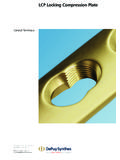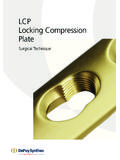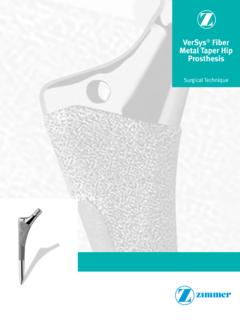Transcription of Surgical Protocol - ZWAN
1 ANATO.. Femoral Hip System Surgical Protocol INDICATIONS. The indications for use of the total hip replacement prostheses include: Noninflammatory degenerative joint disease, including osteoarthritis and avascular necrosis;. Rheumatoid arthritis;. Correction of functional deformity;. Revision procedures where other treatments or devices have failed; and, Nonunions, femoral neck fractures, and trochanteric fractures of the proximal femur with head involvement that are unmanageable using other techniques. Additional indication specific to use of Anato Stems are with compatible Howmedica Osteonics Constrained Liners: When the stem is to be used with compatible Howmedica Osteonics Constrained Liners, the device is intended for use in primary or revision patients at high risk of hip dislocation due to a history of prior dislocation, bone loss, soft tissue laxity, neuromuscular disease, or intra-operative instability.
2 The Anato Hip Stem is intended for cementless use only and is intended for total and hemi-arthroplasty procedures. CONTRAINDICATIONS. Active infection or suspected latent infection in or about the hip joint;. Bone stock that is inadequate for support or fixation of the prosthesis;. Skeletal immaturity; and, Any mental or neuromuscular disorder that would create an unacceptable risk of prosthesis instability, prosthesis fixation failure, or complications in post-operative care. WARNINGS AND PRECAUTIONS. See package insert for warnings, precautions, adverse effects and other essential product information. Before using Anato Stem instrumentation, verify: Instruments have been properly disassembled prior to cleaning and sterilization;. Instruments have been properly assembled post-sterilization;. Instruments have maintained design integrity; and, Proper size configurations are available.
3 For Instructions for Cleaning, Sterilization, Inspection, and Maintenance of Orthopaedic Medical Devices, refer to LSTPI-B and L24002000. TABLE OF CONTENTS. Pre-operative Planning.. 2. Femoral Neck Resection.. 3. Preparing the Femoral Canal .. 4-5. Broaching.. 6-7. Trial Reduction.. 8-9. Implanting the Stem.. 10-11. Final Reduction.. 12-13. Implant Information.. 14-15. Appendix.. 16-17. Instrumentation.. 18-21. ANATO. Femoral Hip System The Anato Hip Stem is intended for cementless, press-fit application. The proximal region of the stem is coated with PureFix HA over a commercially pure titanium plasma spray substrate. The Anato femoral hip system is suitable for various Surgical approaches, including direct anterior. The total system includes: Left and right monolithic femoral hip implants Neutral and anteverted neck options. There is a 7 degree difference between the two options 8 body sizes ranging from size 1 to size 8.
4 One anatomic stem offset of 130 degrees The stem is designed for use with Stryker V40 femoral heads and their compatible acetabular components. This publication sets forth detailed recommended procedures for using Stryker Orthopaedics devices and instruments. It offers guidance that a surgeon should need, but, as with any such technical guide, each surgeon must consider the particular needs of each patient and make appropriate adjustments when and as required. STEP 1. PRE-OPERATIVE PLANNING. Figure 1 Figure 2 Figure 3. Pre-operative planning aids in Optimal femoral stem fit, prosthetic a range of head offset options. the determination of probable neck length, angle and version The predicted change in leg length implant style and size. The pre- can be evaluated with the use and offset is determined by the operative planning process should of pre-operative X-ray analysis.
5 Relative positioning of the center of take qualitative and quantitative The following parameters should rotation markings on the femoral factors (including patient bone be determined using an A/P and acetabular components. quality, density, and morphology) radiograph: stem size, femoral For example, if a given femoral into consideration in order to offset, leg length, neck angle, and component center of rotation evaluate and select the appropriate center of rotation. marking is superior to the center of instrument/implant system for the rotation marking of the acetabular patient. The Anato stem provides offset component, leg lengthening is across all sizes through a 130 predicted. The desired change in When templating the acetabulum, neck angle. Choose the Anato leg length is determined by the place an acetabulum template template for which the stem size radiographic leg length inequality over the area on the X-ray.
6 Be achieves adequate metaphyseal that was previously determined sure that the cup is well centered fill and recreates the desired leg with an A/P bilateral film. If 8mm within the acetabulum and the size length and offset (Figure 2). This of leg lengthening is required in fills between the tear drop and the engagement can be seen when order to equalize the leg lengths, superior rim. After templating the the end of the lateral flare is at the the center of rotation marking of acetabulum for size, mark the center transition between the metaphyses the femoral component must be of rotation represented by the purple and diaphyses (see arrow in 8mm above the center of rotation dot (Figure 1). Figure 2). The proximal end of the of the acetabular component. Once coated region should then be at the final estimated stem size and the level of the piriformis fossa. The position is determined, the neck Templates template has markings that indicate resection level should be noted the center of the femoral head for (Figure 3).
7 This will be used as a ANATO Acetate reference during intra-operative Templates neck resection. Lit# LTEM107. Acetate templates include 20% magnification. 2 ANATO Surgical TECHNIQUE. STEP 2. FEMORAL NECK RESECTION. Saddle Single Osteotomy Dual Osteotomy Approximation of Piriformis Medial 45 Medial Fossa Resection Resection 60 . Intertrochanteric line Point Point Femoral Axis Femoral Axis Femoral Axis Figure 4 Figure 5 Figure 6. A proper neck resection level directly Single Osteotomy Dual Osteotomy (Optional). affects the final placement and fit The neck osteotomy should start Illustrated is a view of the proximal of the femoral stem. As the visual at the saddle proximal to the femur highlighting the landmarks landmarks for Surgical approaches intertrochanteric line and extend that are typically visible from the may vary, it is important to note that distally at approximately a 45 posterior approach (Figure 6).
8 The different landmarks may be used degree angle with respect to the point represents the insertion area to aid in locating the appropriate femoral shaft (Figure 5). If the of the piriformis tendon. This neck resection. (Figure 4). The height intertrochanteric line cannot be resection consists of two separate of the cut can be adjusted in line approximated, an estimation of cuts. The first is a vertical cut to with the templating activity in order the femoral axis will also aid in the depth of the insertion of the to reconstruct the correct patient approximating the direction of the piriformis tendon. The second cut is anatomy. cut. approximately 60 degrees from the Illustrated is a view of the proximal femoral axis to the medial resection femur with the anterior landmarks cut. highlighted (Figure 4). Outlined in blue is the intertrochanteric line which represents the origin of the quadriceps muscle and the insertion of the anterior capsule.
9 The second landmark, the saddle (green line), is a shape created by the outline of the superior aspect of the head-neck- Note greater trochanter. This helps define the starting point for the femoral The medial resection point will serve as a reference for depth neck osteotomy. and seating of the broaches and stems in the subsequent steps and operations. 3 ANATO Surgical TECHNIQUE. STEP 3. PREPARING THE FEMORAL CANAL. To help ensure proper final orientation of the stem, lateral preparation may be required. Retraction of the gluteus medius and removal of a portion of the superior lateral neck and/or piriformis fossa will permit true axial introduction of the instruments and implant. A box osteotome is useful in removing bone from this area. Connect the box osteotome to the broach handle. Use a mallet to strike the end of the broach handle with careful controlled blows to remove bone of the superior femoral neck and open the medullary canal.
10 Figure 7. Instruments MIS Modular 8mm Hollow Box Offset Broach Handle Chisel 4849-8-108 1020-1460. 4 ANATO Surgical TECHNIQUE. STEP 3. PREPARING THE FEMORAL CANAL CONTINUED. Distal Reaming The Anato hip stem design encourages metaphyseal load transfer. This design enables engagement in the metaphysis and the prevention of distal fixation. If the pre-operative planning anticipates a potential contact between the stem and the diaphyseal cortex then it is recommended to ream with flexible reamers up to the diameter corresponding to the templated implant size in Table 1 below. This decision may also be made at the time of broaching. TABLE 1: RECOMMENDED REAMING DIAMETER. STEM SIZE DISTAL STEM DIAMETER RECOMMENDED REAMING. (MM) DIAMETER (MM). 1 2 3 Figure 8 4 5 6 7 8 Note The BixCut IM fixed-head system with modified trinkle fitting, can be used to prepare Guide Wire Information: the femur to receive an Anato Note hip stem.














